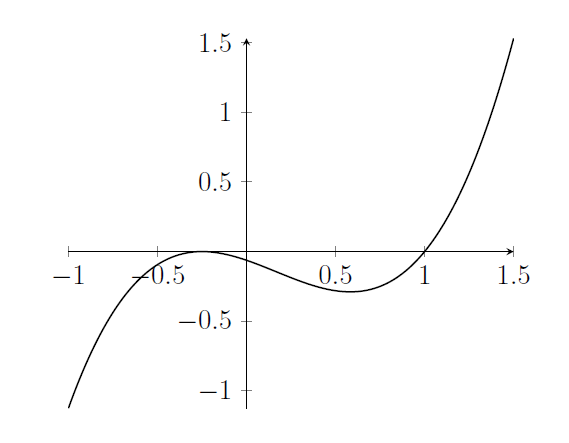Solutions - 2021
Part of the Oxford MAT Livestream
These are the solutions for the Polynomials worksheet.
Here's a copy of what was written during the livestream.
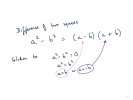 |
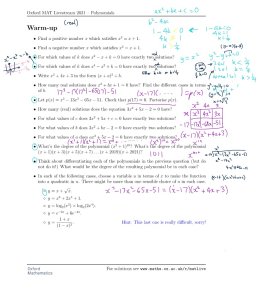 |
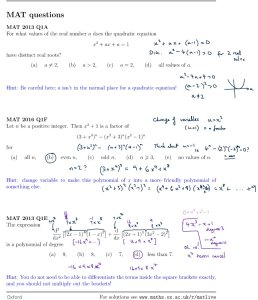 |
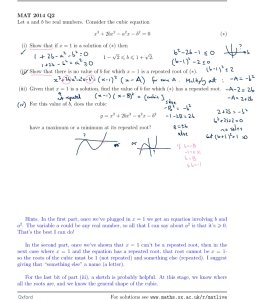 |
Warm-up
- Find a positive number \(x\) which satisfies \(x^2=x+1\).
- We can rearrange to \(x^2-x-1=0\) and then use the quadratic formula for \(x=\frac{1}{2}\left(1\pm \sqrt{5}\right)\). If we choose the solution with the \(+\) sign then we'll get a positive number.
- Find a negative number \(x\) which satisfies \(x^2=x+1\).
- That's the same quadratic equation with solutions \(x=\frac{1}{2}\left(1\pm \sqrt{5}\right)\). If we choose the solution with the \(-\) sign then we'll get a negative number, because \(\sqrt{5}>1\).
- For which values of \(k\) does \(x^2-x+k=0\) have exactly two solutions?
- The discriminant for this quadratic is \(1-4k\). There are exactly two solutions if this is positive, which happens when \(k<\frac{1}{4}\).
- For which values of \(k\) does \(x^4- x^2+k=0\) have exactly two solutions?
- This is not a quadratic, but if we change variable by writing \(u=x^2\) then we get \(u^2-u+k=0\). That's got two solutions if \(k<\frac{1}{4}\), one solution if \(k=\frac{1}{4}\), and no real solutions if \(k>\frac{1}{4}\) (thinking about the discriminant again). But let's be careful, because that's the number of solutions there are for \(u\), and we really want to know how many solutions there are for \(x\).
- If there are no real solutions for \(u\) then there can't be any real solutions for \(x\). So that rules out \(k>\frac{1}{4}\). If there's exactly one solution for \(u\) then we might get two real solutions for \(x\); they'd be \(\pm\sqrt{u}\), but that only works if the solution for \(u\) is a positive number. In the case \(k=\frac{1}{4}\), we've got one solution for \(u\), and if we write down the quadratic formula then that solution is actually \(\frac{1}{2}\), so we do get two real solutions for \(x\). In the other remaining case \(k<\frac{1}{4}\) there are two real solutions for \(u\). That could give us as many as four real solutions for \(x\). We'd get exactly two real solutions for \(x\) if and only if one of the solutions for \(u\) is positive and one is negative. Thinking about the factorisation \((u-a)(u-b)\), we can see that the constant term \(k\) in our quadratic for \(u\) would have to be negative for there to be one positive solution and one negative solution. So we would get two real solutions for \(x\) only if \(k<0\).
- Putting all that together, there are two real solutions for \(x\) if \(k<0\) or if \(k=\frac{1}{4}\), and for no other values of \(k\).
- Write \(x^2+4x+3\) in the form \((x+a)^2+b\).
- If I imagine multiplying out \((x+a)^2\), then I would get a term \(2ax\), and I want that to match with the \(4x\) term. So I'll take \(a=2\). Then if I multiply out \((x+2)^2\), I'd get a term \(+4\) at the end; that's not quite what I want, so I'll take \(b=-1\) to fix the constant coefficient of this quadratic. I get \((x+2)^2-1\).
- How many real solutions does \(x^2+bx+1=0\) have? Find the different cases in terms of \(b\).
- The discriminant is \(b^2-4\). That's positive (and the quadratic has two real solutions) if \(b>2\) or if \(b<-2\). If \(b=\pm 2\) then the quadratic has one solution. If \(-2<b<2\) then the quadratic has no real solutions.
- Let \(p(x)=x^3-13x^2-65x-51\). Check that \(p(17)=0\). Factorise \(p(x)\).
- First we're asked to check that \(17^3-13\times 17^2-65\times 17-51=0\). To make this easier, don't work out the terms individually. Instead pull out factors of \(17\);
- \(17^3-13\times 17^2-65\times 17-51=17\left(17^2-13\times 17 -65-3\right)\) because \(51=3\times 17\).
- \(17^2-13\times 17 -68=17\left(17-13-4\right)\) because \(68=4\times 17\).
- \(17-3-4=0\) so each line above is equal to zero.
- By the Factor Theorem, if \(p(17)=0\) then \((x-17)\) is a factor of the polynomial. Doing some polynomial division, we can work out that \(p(x)=(x-17)(x^2+4x+3)\). We can then write \(x^2+4x+3=\left(x+3\right)\left(x+1\right)\) and we've factorised \(p(x)\).
- How many (real) solutions does the equation \(3x^2+5x-2=0\) have?
- The discriminant is \(5^2-4\times 3\times(-2)=49>0\), so there are two real solutions.
- For what values of \(c\) does \(3x^2+5x+c=0\) have exactly two solutions?
- The discriminant is \(25-12c\), which is positive if \(c<\frac{25}{12}\).
- For what values of \(b\) does \(3x^2+bx-2=0\) have exactly two solutions?
- The discriminant is \(b^2+24\), which is always positive.
- For what values of \(a\) does \(ax^2+5x-2=0\) have exactly two solutions?
- The discriminant is \(25+8a\) which is positive if \(a>-\frac{25}{8}\).
- What's the degree of the polynomial \((x^2+1)^{10}\)? What's the degree of the polynomial \((x+1)(x+3)(x+5)(x+7)\dots (x+2019)(x+2021)\)?
- The highest power in the first polynomial comes from \(\left(x^2\right)^{10}\), so the degree of the polynomial is \(20\).
- The second polynomial has an \(x\) in each bracket, so the highest power will come when all of those are multiplied together. There are \(1011\) terms here, so the degree of the polynomial is \(1011\).
- Think about differentiating each of the polynomials in the previous question (but do not do it!) What would be the degree of the resulting polynomial be in each case?
- Differentiating reduces the degree of a polynomial by \(1\), so the resulting polynomials will have degrees \(19\) and \(1010\) respectively.
- In each of the following cases, choose a variable \(u\) in terms of \(x\) to make the function into a quadratic in \(u\). There might be more than one sensible choice of \(u\) in each case.
- \(y=x+\sqrt{x}\). Choosing \(u=\sqrt{x}\) gives \(y=u^2+u\).
- \(y=x^8+2x^4+1\). Choosing \(u=x^4\) gives \(y=u^2+2u+1\).
- \(y=\log_2(x^2)\times\log_2(2x^4)\). Laws of logarithms give \(y=2\log_2 x \left(1+4\log_2x\right)\). Choosing \(u=\log_2 x\) gives \(y=2u\left(1+4u\right)\).
- \(y=e^{-2x}+6e^{-4x}\). Choosing \(u=e^{-2x}\) gives \(y=u+6u^2\).
- \(\displaystyle y=\frac{1+x}{(1-x)^2}\). We can rearrange this to \(\displaystyle y=\frac{(x-1)+2}{(1-x)^2}=\frac{-1}{1-x}+\frac{2}{(1-x)^2}\). Choosing \(\displaystyle u=\frac{1}{1-x}\) gives \(y=-u+2u^2\).
MAT questions
MAT 2013 Q1A
- We can rearrange to get \(x^2+ax+a-1=0\).
- The discriminant is \(a^2-4(a-1)=a^2-4a+4=(a-2)^2\).
- That's either zero or positive (because it's the square of a number). It's only zero if \(a=2\), so we have distinct real roots if \(a\neq 2\).
- The answer is (a).
MAT 2016 Q1F
- If we write \(u=x^2\) then this polynomial becomes \((3+u^2)^n-(u+3)^n(u-1)^n\) and we would like to know whether \((u+1)\) is a factor.
- That's the case if and only if \(u=-1\) is a root. If we substitute in \(u=-1\) then we get \(4^n-2^n(-2)^n\). That's zero if and only if \(n\) is even.
- The answer is (b).
MAT 2013 Q1E
- First let's think about the term with the highest power of \(x\) from the first part of the expression \[\frac{\mathrm{d}^2}{\mathrm{d}x^2}\left[(2x-1)^4(1-x)^5\right].\]
- That comes from the highest power of \(x\) inside the square brackets being differentiated twice. Thinking about what happens if the brackets are multiplied out, the term inside the square brackets with the highest power of \(x\) would be \((2x)^4(-x)^5=-16x^9\). If we differentiate that term twice we'd get \(-16\times 9 \times 8 x^7\).
- Now let's think about the other part of the expression \(\displaystyle\frac{\mathrm{d}}{\mathrm{d}x}\left[(2x+1)^4(3x^2-2)^2\right].\)
- If we multiplied out all the brackets, then the term inside the square brackets with the highest power of \(x\) would be \((2x)^4(3x^2)^2=16\times 9 x^8\). If we differentiate that then we get \(16\times 9\times 8x^7\).
- Those two terms cancel! So overall there are no terms of degree higher than 7, and no term of degree 7. So the degree of the polynomial is less than 7.
- The answer is (d).
MAT 2014 Q2
(i) If \(x=1\) is a solution then \(1+2b-a^2-b^2=0\). We can rearrange this and complete the square to get \(2-(b-1)^2=a^2\). We're looking for an inequality that doesn't involve \(a\) so let's use the fact that \(a^2\geq 0\). That gives \(2-(b-1)^2\geq 0\) so \((b-1)^2\leq 2\). That happens if \(1-\sqrt{2}\leq b \leq 1+\sqrt{2}\).
(ii) If \(x=1\) is a repeated root, then the cubic must factorise as \((x-A)(x-1)^2\) for some real number \(A\) (thinking carefully about the leading coefficient of \(x^3\)). If we multiply that out and compare coefficients with the cubic that we've got, we find that \[1=1\quad \text{and}\quad 2b=-A-2\quad\text{and}\quad -a^2=1+2A\quad\text{and}\quad -b^2=-A.\]
The second and fourth equations give \(A=b^2\) and so \(b^2+2b+2=0\). But \(b^2+2b+2=(b+1)^2+1\) is always positive and never zero. So there's no value of \(b\) that works, so \(x=1\) can never be a repeated root.
(iii) If \(x=1\) and there's is a repeated root, then the repeated root cannot be \(x=1\) by part (ii), so the cubic must factorise as \((x-B)^2(x-1)\) for some real number \(B\) (thinking carefully about the leading coefficient of \(x^3\)). If we multiply that out and compare coefficients with the cubic that we've got, we find that \[1=1\quad\text{and}\quad 2b=-2B-1 \quad\text{and}\quad -a^2=B^2+2B \quad\text{and}\quad -b^2=-B^2. \]
The last equation gives \(B=\pm b\), and if we then plug this into the second equation, we get either \(2b=-2b-1\) or \(2b=2b-1\). The second option doesn't have any solutions for \(b\), but the first option has solution \(b=-\frac{1}{4}\), which is the number we're looking for.
For this value of \(b\), the cubic is \(\left(x+\frac{1}{4}\right)^2\left(x-1\right)\). Near to \(x=-\frac{1}{4}\), the term \(x-1\) is negative, so the cubic is negative on either side of that repeated root. It has a maximum at its repeated root.
Reflection
- Here are a couple of tricks for the quadratic \(x^2+ax+b=0\) in the case that there are two real roots; that is if \(a^2> 4b\). You can always work these out with the quadratic formula or by thinking about the factorisation \((x-\alpha)(x-\beta)\), but I've found it helpful to have these memorised.
- If \(b<0\) then one of the roots is positive and one is negative.
- If \(b>0\) then either both of the roots are positive, or both of the roots are negative.
- If \(a>0\) then the mean of the roots is negative. If \(a<0\) then the mean of the roots is positive.
- Completing the square is important, because it reduces the number of times the variable appears from two to one. That's great if we're trying to solve (it leads to the quadratic formula), and it's also useful if we're trying to work out inequalities for the variable, like in the first part of the long question above which has a quadratic for \(b\).
- Several of the questions on this worksheet involve a quadratic with a parameter in (like the parameter \(a\) in the first MAT question above). As we work through the question we start with a quadratic in \(x\) and then later consider a quadratic in \(a\). It was important for us to be able to recognise this quadratic in a different variable, and to be able to think about what the roots of this quadratic mean (without mixing that up with the roots of the original quadratic).


